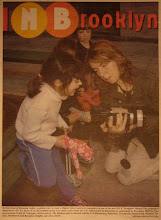As of this summer, I am formally refocusing my children and video energies into making
Little Creatures, my new film company, a reality. I am currently writing and rewriting my business plan, which I have submitted and will submit to future business plan

competitions, reading everything I can about the film and children's media businesses, and talking to people in these fields. My hope is that Little Creatures will receive seed money from an angel investor within the next year, so that I can complete
Mysteries in the Woods and also produce another short film I am currently planning to make with children in Brooklyn, which I believe could revolutionize the children's film genre. If you know of any potential funders, do send them my way, and I will gladly provide business plan and work samples. I am also seeking families who would like to participate in my market research, which will consist of viewing a DVD compilation of my short films with their children, and answering a few questions about the films and their children's interaction with them. The data that I gather from these ongoing conversations with parents and children will help me to frame my work in the context of what media is out there for children, what is needed, and how my work can better fill that gap and flourish as a viable option for parents to buy and view with their young children. Perhaps these conversations will bring similar endorsements to what I have heard so far:
• Kristin captured the authentic sights and sounds of childhood . . . she uses her camera as a lens into the deepest inner-workings of a child’s mind . . .
-
Vivian Gussin Paley, author of 12 books on the lives of young children
• The remarkable videos made by Kristin are unique in their ability to bring us into the very life of childhood play itself. Wonderful as tools for teaching the importance of play - or as a means to validate for children why their playing is always meaningful, these videos should be made available to anyone who cares for what learning and education need to be about – and could become.
- Richard Lewis, Director of the
Touchstone Center for Children• I believe that, in honoring children’s play, Kristin’s movies will also help audiences reflect and learn about the overall experience of being human.
-
Olga Hubard, Assistant Professor of Art Education, Columbia University Teachers College
• I would gladly support more initiatives such as these that speak to the true essence of childhood and would rather put my dollars in movies and projects like these.
-
Kathy Malone, Clothing Designer and Mother of Milo (10), Brooklyn, NY
I am very interested to compile specific reactions of parents and children to my films, which will help me immensely as I restructure future projects, and which will strengthen the argument for making more of these films, as only research can do.
 I wrote an article for Youth Media Reporter, and it has come out in the online edition of the journal, Vol. 2 Issue 6. The print version will be available in January. It is called Not too young to watch, not too young to make, and features several of the children I worked with last year at PS 27 in Red Hook, Brooklyn. Here is an excerpt:
I wrote an article for Youth Media Reporter, and it has come out in the online edition of the journal, Vol. 2 Issue 6. The print version will be available in January. It is called Not too young to watch, not too young to make, and features several of the children I worked with last year at PS 27 in Red Hook, Brooklyn. Here is an excerpt:

















